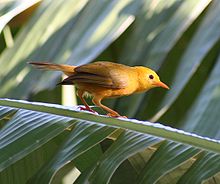Golden white-eye
| Golden white-eye | |
|---|---|

| |
| Scientific classification | |
| Domain: | Eukaryota |
| Kingdom: | Animalia |
| Phylum: | Chordata |
| Class: | Aves |
| Order: | Passeriformes |
| Family: | Zosteropidae |
| Genus: | Cleptornis Oustalet, 1889 |
| Species: | C. marchei
|
| Binomial name | |
| Cleptornis marchei | |
| Synonyms | |
|
Ptilotis marchei | |
The golden white-eye (Cleptornis marchei) is a species of
Fossil evidence shows the golden white-eye once also occurred on
Taxonomy
The species was once called the golden honeyeater as it was considered to be a
Subsequent studies have supported the idea that this species was a white-eye.
Its generic name, Cleptornis, is derived from the Ancient Greek kleptes, a robber or thief, and ornis, a bird. This is not a reference to any aspect of the golden white-eye's behaviour, but to the old French name of the Mariana Islands, les Îles des Voleurs, or Robbers' Islands.[7] The specific epithet marchei refers to the French explorer and writer Antoine-Alfred Marche, who procured the original specimens.[8]
Distribution and habitat
The golden white-eye is
Description
The golden white-eye differs from the other white-eyes in having large eyes and an outermost
The golden white-eye makes a variety of calls. The song is a long raspy warble, rendered as "séé mé-can you séé mé-I can séé yóú-can you séé mé". The species also makes rasping shorter calls and whistles when in flocks and in flight. Chicks give plaintive whistles when begging for food from adults.[2]
Behaviour
Like other white-eyes, the golden white-eye is
Diet and feeding

The golden white-eye is a generalist, feeding on fruit, berries, and
Breeding
Breeding occurs throughout the year on Saipan, where the species' nesting behaviour has been studied.[13] The peak breeding period seems to be from March to July.[4] The species is monogamous. The nests are simple undecorated cups of casuarina needles, grasses, and vines. These are placed around 2.9 m (between 1.5 and 6.5 m) off the ground in a variety of trees including Casuarina, Guamia, Cynometra, Leucaena, and Citrus.[13] The nests are predated by other bird species, specifically Micronesian starlings and collared kingfishers,[14] as well as the introduced green tree skink.[4]
The typical
Threats and conservation

The range of the golden white-eye has contracted considerably since the arrival of humans in the Mariana Islands. Fossil bones of this species have been found on the nearby islands of Tinian and Rota, and it may once have occurred on Guam and other islands in the Marianas.[15]
At present the golden white-eye is very common, and in fact a 1996 study found that their densities on Saipan were among the highest recorded for any bird, up to 2,095 birds/km² (8.47 per acre).[10] It was believed that Saipan cannot sustain a larger population of this white-eye than it already does.[16] A 2009 study, which incorporated results from a 2007 survey, found that the species had declined between 1982 and 2007, in common with two other species on Saipan, the rufous fantail and the nightingale reed warbler. All three species are insectivorous and were theorised to have declined due to habitat loss. Nevertheless, the species remained relatively abundant, and the current world population is estimated at around 71,997 birds.[17]
The species is nonetheless evaluated as
References
- ^ . Retrieved 17 November 2021.
- ^ ISBN 978-84-96553-45-3.
- ^ (in French) Oustalet, E. (1889). Note sur la faune ornithologique des Res Mariannes. Le Naturaliste 3(64): 260.
- ^ ISBN 978-0955260759.
- ISBN 0-691-08402-5.
- ^ JSTOR 4089717. Retrieved 27 January 2016.
- ISBN 0-19-854634-3.
- ^ Baker, Rollin H. (1951). "The avifauna of Micronesia, its origin, evolution and distribution". University of Kansas Publications, Museum of Natural History. 3 (1): 303. Retrieved 20 January 2009.
- ^ a b c d Craig, Robert (1990). "Foraging behavior and microhabitat use of two species of white-eyes (Zosteropidae) on Saipan, Micronesia" (PDF). Auk. 107 (3): 500–505. Retrieved 20 January 2009.
- ^ a b Craig, Robert (1996). "Seasonal population surveys and natural history of a Micronesian bird community" (PDF). Wilson Bulletin. 108 (2): 246–267.
- .
- ^ .
- ^ a b c d Stinson, Colleen; Derek Stinson (1994). "Nest sites, clutch size and incubation behavior in the Golden White-Eye" (PDF). Journal of Field Ornithology. 65 (1): 65–69. Retrieved 20 January 2009.
- ^ Sachtleben, Thalia (2005). Predation and nest success of forest birds in native and nonnative habitat on Saipan, Mariana Islands (PDF) (MSc thesis). Colorado State University. pp. 1–95. Archived from the original (PDF) on 2010-07-22.
- ISBN 978-0-226-77142-7.
- ISBN 978-0-9552607-3-5.
- .
- JSTOR 1938471.
- ^ Craig, Robert (1998). "Conservation of endangered white-eyes (Zosteropidae) in the tropical Pacific". 22nd International Ornithological Conference (PDF). Putnam, CT, and Durban, South Africa: Bird Conservation Research, Inc. pp. 1–8. Archived from the original (PDF) on 2016-03-04. Retrieved 2008-11-14.
- ^ Bonner, Jeffrey (2008). "Reptilian invasion: Saving Pacific island birds from snakes". St. Louis Post-Dispatch. Archived from the original on 17 September 2008. Retrieved 14 November 2008.
- ^ BirdLife International (2008). "BirdLife Species Factsheet: Golden White-eye". Retrieved 15 January 2009.
- ^ Zombeck, Debbie (Winter 2011). "A Feather in Our Cap" (PDF). Alive: Magazine of the North Carolina Zoological Society. 63: 5. Archived from the original (PDF) on 2013-12-03. Retrieved 2012-11-25.
External links
 Media related to Cleptornis marchei at Wikimedia Commons
Media related to Cleptornis marchei at Wikimedia Commons Data related to Cleptornis marchei at Wikispecies
Data related to Cleptornis marchei at Wikispecies

